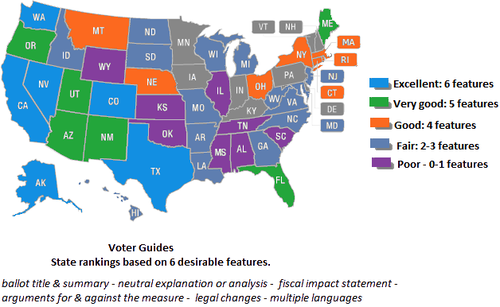Ballotpedia assigns grades to state ballot measure voter guides: Difference between revisions
m (Inventory category installation for: Archived_news_articles) |
(No difference)
|
Latest revision as of 02:20, 11 August 2021
November 21, 2014
Each year, various secretaries of state and other state agencies publish official voter guides, which are designed to help voters navigate what will appear on upcoming ballots. Ballotpedia, in turn, analyzes these guides, specifically in respect to their coverage of ballot measures, and ranks them according to how thorough and informative they are. Voter guides vary drastically in comprehensiveness from state to state. Some guides list nothing more than the text of the measure as it will appear on the ballot; others include in-depth analyses of what the approval of the measure would mean for the state, as well as support and opposition arguments. Some states even go so far as to publish the voter guides in multiple languages.
Features
For 2014, Ballotpedia ranked each state on a six-point scale based on the availability of the desirable features in a state's voter guide. The six desirable features that were, or in many cases were not, found in the online voter information materials published by 42 state governments to familiarize voters with statewide ballot measures included:
- Official ballot language - This may include the ballot title and official ballot summary.
- Neutral explanation or analysis - This is a short summary by a governmental agency of the key points. Some summaries can run multiple pages, while others are only a paragraph or two long.
- Fiscal impact statement - This is generally a detailed explanation of how the measure will affect state finances if approved by voters.
- Arguments for and against the measure - These are typically statements written by supporters or opponents, detailing their arguments, but they may also be general points compiled by the agency publishing the guides. Some states allow comments from the public to be submitted as well.
- Text of the measure - This is the full text of the statute or amendment that will become law if the measure is approved, and often includes mark-ups to show exactly how the law was changed.
- Documentation in multiple languages - Official voter guides are always published in English, but some states will publish them in other languages, such as Spanish, and formats, such as audio.
Scores
Ballotpedia graded each state according to how informative and comprehensive its voter guide was (see the map above). The following scale was used to assign grades to each of the states:
- Excellent: 6 features
- Very good: 5 features
- Good: 4 features
- Fair: 2 - 3 features
- Poor: 0 - 1 features
Of the 42 states that featured ballot measures in 2014, only four - Alaska, California, Nevada and Washington - published voter guides that included all six desirable features and received scores of "excellent." Another three - Kansas, Mississippi and South Carolina - did not publish any official voter guides. Therefore, all three of these states automatically received grades of "poor." Seven states received grades of "very good," eight states were graded as "good," 14 fell within the "fair" category and a total of 9 received "poor" scores. The breakdown of states is as follows:


